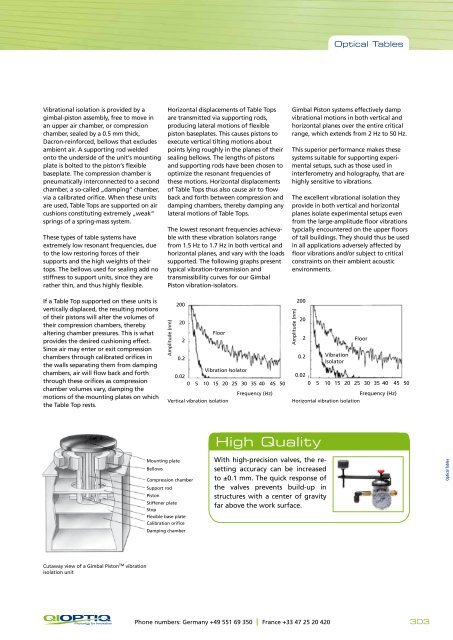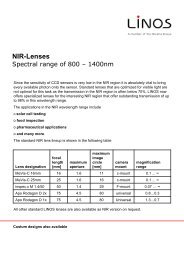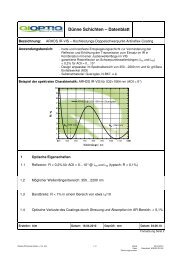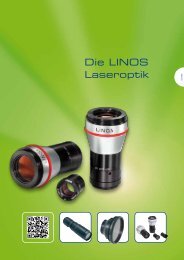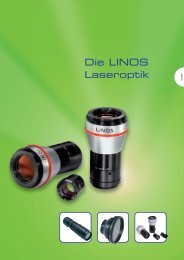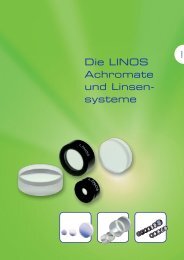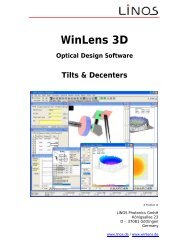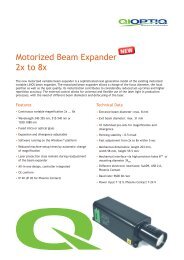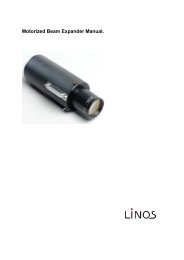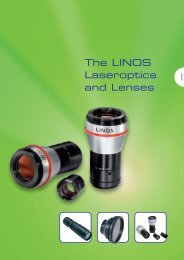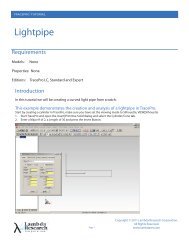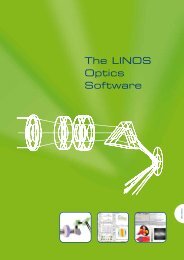08-Optical Tables.pdf - Qioptiq Q-Shop
08-Optical Tables.pdf - Qioptiq Q-Shop
08-Optical Tables.pdf - Qioptiq Q-Shop
You also want an ePaper? Increase the reach of your titles
YUMPU automatically turns print PDFs into web optimized ePapers that Google loves.
<strong>Optical</strong> <strong>Tables</strong><br />
Vibrational isolation is provided by a<br />
gimbal-piston assem bly, free to move in<br />
an upper air chamber, or com pres sion<br />
chamber, sealed by a 0.5 mm thick,<br />
Dacron -reinforced, bellows that excludes<br />
ambient air. A suppor ting rod welded<br />
onto the underside of the unit‘s moun ting<br />
plate is bolted to the piston‘s flexible<br />
base plate. The compression chamber is<br />
pneumatically inter connected to a second<br />
chamber, a so-called „damping“ chamber,<br />
via a calibrated orifice. When these units<br />
are used, Table Tops are supported on air<br />
cushions consti tu ting extrem ely „weak“<br />
springs of a spring-mass system.<br />
These types of table systems have<br />
extremely low reso nant frequencies, due<br />
to the low restoring forces of their<br />
supports and the high weights of their<br />
tops. The bellows used for sealing add no<br />
stiffness to support units, since they are<br />
rather thin, and thus highly flexible.<br />
Horizontal displacements of Table Tops<br />
are transmitted via supporting rods,<br />
producing lateral motions of flexible<br />
piston baseplates. This causes pistons to<br />
execute vertical tilting motions about<br />
points lying roughly in the planes of their<br />
sealing bellows. The lengths of pistons<br />
and supporting rods have been chosen to<br />
optimize the resonant frequencies of<br />
these motions. Horizontal dis place ments<br />
of Table Tops thus also cause air to flow<br />
back and forth between compression and<br />
damping chambers, thereby damping any<br />
lateral motions of Table Tops.<br />
The lowest resonant frequencies achievable<br />
with these vibration isolators range<br />
from 1.5 Hz to 1.7 Hz in both vertical and<br />
horizontal planes, and vary with the loads<br />
supported. The following graphs present<br />
typical vibra tion -transmission and<br />
transmissibility curves for our Gimbal<br />
Piston vibration-isolators.<br />
Gimbal Piston systems effectively damp<br />
vibrational motions in both vertical and<br />
horizontal planes over the entire critical<br />
range, which extends from 2 Hz to 50 Hz.<br />
This superior performance makes these<br />
systems suitable for supporting experimental<br />
setups, such as those used in<br />
interferometry and holography, that are<br />
highly sensitive to vibrations.<br />
The excellent vibrational isolation they<br />
provide in both vertical and horizontal<br />
planes isolate experimental setups even<br />
from the large-amplitude floor vibrations<br />
typcially encountered on the upper floors<br />
of tall buil dings. They should thus be used<br />
in all applications ad versely affected by<br />
floor vibrations and/or subject to critical<br />
constraints on their ambient acoustic<br />
environ ments.<br />
If a Table Top supported on these units is<br />
vertically displaced, the resulting motions<br />
of their pistons will alter the volumes of<br />
their compression chambers, thereby<br />
altering chamber pressures. This is what<br />
provides the desired cushioning effect.<br />
Since air may enter or exit compression<br />
chambers through calibrated orifices in<br />
the walls separating them from damping<br />
chambers, air will flow back and forth<br />
through these orifices as com pres sion<br />
chamber volumes vary, damping the<br />
motions of the mounting plates on which<br />
the Table Top rests.<br />
Amplitude (nm)<br />
200<br />
20<br />
Floor<br />
2<br />
0.2<br />
Vibration Isolator<br />
0.02<br />
0 5 10 15 20 25 30 35 40 45 50<br />
Frequency (Hz)<br />
Vertical vibration isolation<br />
Amplitude (nm)<br />
200<br />
20<br />
2<br />
0.2<br />
Vibration<br />
Isolator<br />
Floor<br />
0.02<br />
0 5 10 15 20 25 30 35 40 45 50<br />
Frequency (Hz)<br />
Horizontal vibration isolation<br />
High Quality<br />
Mounting plate<br />
Bellows<br />
Compression chamber<br />
Support rod<br />
Piston<br />
Stiffener plate<br />
Stop<br />
Flexible base plate<br />
Calibration orifice<br />
Damping chamber<br />
With high-precision valves, the resetting<br />
accuracy can be increased<br />
to ±0.1 mm. The quick response of<br />
the valves prevents build-up in<br />
structures with a center of gravity<br />
far above the work surface.<br />
<strong>Optical</strong> <strong>Tables</strong><br />
Cutaway view of a Gimbal Piston TM vibration<br />
isolation unit<br />
Phone numbers: Germany +49 551 69 350<br />
France +33 47 25 20 420<br />
303


